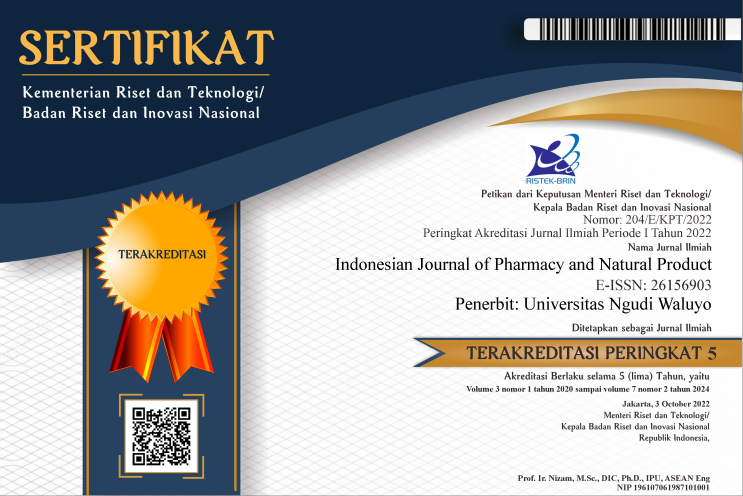Profil Klinik dan Farmakoterapi Anti-Dislipidemia Diabetes di Rumah Sakit Gunawan Mangunkusumo Ambarawa
Clinical and Pharmacotherapeutic Profile of Anti-Diabetic Dyslipidemia at Gunawan Mangunkusumo Hospital
DOI:
https://doi.org/10.35473/ijpnp.v8i01.3559Abstract
Dyslipidemia is characterized by increased plasma TG, low HDL-c, and high LDL-c, which is commonly found in patients with diabetes mellitus (DM) and is one of the main causes of ischemic stroke and cardiovascular death risk. This study aims to describe the clinical profile and pharmacotherapy of diabetic dyslipidemia drugs at GM Hospital. This study is a descriptive cross-sectional study by collecting data from medical records of diabetic dyslipidemia patients treated at GMA Hospital from January to December 2022. Antidiabetic and antidyslipidemic drugs prescribed by clinicians were collected and presented in tables and figures. The study showed that 28 (37.84%) were male and 46 (62.16%) were female. The average age of the population was 56.71 ± 13.60 years. Clinical profile with TC: 200.73 ± 56.40 mg/dL (limit), LDL-c level: 132.73 ± 57.67 mg/dL (almost optimal), and TG: 280.76 ± 169.40 mg/dL. Antidyslipidemic drugs were Fenofibrat (58.57%) and Atorvastatin (41.46%). Antidiabetic drugs were insulin Aspart (IAsp) (86.49%), insulin Degludec (IDeg) (4.05%), IDegAsp (combination of IDeg and IAsp) (5.41%), and Glimepiride (4.05%). The pattern of drug prescription in diabetic dyslipidemia patients was a combination of Fenofibrate-IAsp (45.95%); Atorvastatin-IAsp (29.73%); Fenofibrate-Atorvastatin-IAsp (10.51%); Atorvastatin-IDegAsp (5.41%); Fenofibrate-IDegAsp, and Fenofibrat-Glimepiride (4.05%, respectively). This study implies that insulin and Fenofibrate or Atorvastatin are the main drug groups for the treatment of diabetic patients with dyslipidemia either when used alone or in combination. Further studies focus on the reasons for drug safety and quality of life.
ABSTRAK
Dislipidemia ditandai dengan peningkatan plasma TG, HDL-c rendah, dan LDL-c tinggi, yang umum ditemukan pada subyek dibetes mellitus (DM) dan merupakan salah satu penyebab utama stroke iskemik dan resiko kematian kardiovaskular. Penelitian ini bertujuan untuk mendeskripsikan profil klinik dan farmakoterapi obat diabetes dislipidemia diabetik di Ruamh Sakit Gunawan Mangunkuumo (RSGM). Penelitian ini bersifat deskriptif cross sectional dengan mengumpulkan data dari rekam medis subyek diabetes dislipidemia yang dirawat di RS GMA pada bulan Januari sampai dengan Desember 2022. Obat antidiabetik dan antidislipidemia yang diresepkan oleh klinisi dikumpulkan dan disajikan dalam bentuk tabel dan gambar. Penelitian menunjukkan bahwa 28 (37,84%) berjenis kelamin laki-laki dan 46 (62,16%) perempuan. Rata-rata usia populasi 56,71 ± 13,60 tahun. Profil klinik dengan TC: 200,73 ± 56,40 mg/dL (batas), kadar LDL-c: 132,73 ± 57,67 mg/dL (hampir optimal), dan TG: 280,76 ± 169,40 mg/dL. Obat antidislipidemia adalah Fenofibrat (58,57%) dan Atorvastatin (41,46%). Obat antidiabetes adalah insulin Aspart (IAsp) (86,49%), insulin degludec (IDeg) (4,05%), IDegAsp (kombinasi IDeg dan IAsp) (5,41%), dan Glimepiride (4,05%). Pola peresepan obat pada subyek dislipidemia diabetik adalah kombinasi Fenofibrat-IAsp (45,95%); Atorvastatin-IAsp (29,73%); Fenofibrat-Atorvastatin-IAsp (10,51%); Atorvastatin-IDegAsp (5,41%); Fenofibrat-IDegAsp, dan Fenofibrat-Glimepiride masing-masing (4,05%). Studi ini menyiratkan bahwa insulin dan Fenofibrat atau Atorvastatin merupakan kelompok obat utama untuk pengobatan subyek dislipidemia diabetes baik bila digunakan sendiri maupun dalam kombinasi. Studi lebih lanjut berfokus pada alasan keamanan obat dan kualitas hidup.
References
Aderibigbe MA, Obafemi TO, Olaleye MT, & Akinmoladun, A. C. (2018). Effects of gender, age and treatment duration on lipid profile and renal function indices in diabetic patients attending a teaching hospital in South-Western Nigeria. African health sciences, 18(4), 900–908.
Ahmmed MS, Shuvo SD, Paul DK, Karim MR, Kamruzzaman M, Mahmud N, et al. (2021). Prevalence of dyslipidemia and associated risk factors among newly diagnosed Type-2 Diabetes Mellitus (T2DM) patients in Kushtia, Bangladesh. PLOS Glob Public Health 1(12): E0000003.
Al Quran TM, Bataineh ZA, Al-Mistarehi AH, Zein Alaabdin AM, Allan H, Al Qura’an A, et al. (2022). Prevalence and Pattern of Dyslipidemia and Its Associated Factors Among Patients with Type 2 Diabetes Mellitus in Jordan: A Cross-Sectional Study. International Journal of General Medicine, 15, 7669–7683.
Allaire J, Vors C, Couture P, & Lamarche B, (2017). LDL particle number and size and cardiovascular risk: anything new under the sun?. Current Opinion in Lipidology, 28(3), 261–266.
American Diabetes Association (AMA). (2018). Pharmacologic Approaches to Glycemic Treatment: Standards of Medical Care in Diabetes-2018. Diabetes Care. 41(Suppl 1), S73–S85.
Anderson TJ, Grégoire J, Pearson GJ, Barry AR, Couture P, Dawes M, et al. (2016). Canadian Cardiovascular Society Guidelines for the Management of Dyslipidemia for the Prevention of Cardiovascular Disease in the Adult. Can J Cardiol. 2016;32(11):1263-1282.
Anto EO, Obirikorang C, Annani-Akollor ME, Adua E, Donkor S, Acheampong E., et al. (2019). Evaluation of Dyslipidaemia Using an Algorithm of Lipid Profile Measures among Newly Diagnosed Type II Diabetes Mellitus Patients: A Cross-Sectional Study at Dormaa Presbyterian Hospital, Ghana. Medicina (Kaunas, Lithuania), 55(7), 392.
Arias-Loza PA, Muehlfelder M, & Pelzer T. (2013). Estrogen and estrogen receptors in cardiovascular oxidative stress. Pflugers Archiv : European Journal of Physiology, 465(5), 739–746.
Baena-Díez JM, Peñafiel J, Subirana I, Ramos R, Elosua R, Marín-Ibañez A, et al. … FRESCO Investigators. (2016). Risk of Cause-Specific Death in Individuals With Diabetes: A Competing Risks Analysis. Diabetes Care, 39(11), 1987–1995.
Balasubramanian R, Demler O, Guasch-Ferré M, Paynter NP, Sheehan R, Liu, S., et al. (2020). Metabolomic Effects of Hormone Therapy and Associations With Coronary Heart Disease Among Postmenopausal Women. Circulation. Circulation. Genomic and Precision Medicine, 13(6), E002977.
Bansal AB, & Cassagnol, M, (2023). HMG-CoA Reductase Inhibitors. [Updated 2023 Jul 3]. In: StatPearls [Internet]. Treasure Island (FL): StatPearls Publishing; 2023 Jan-. In StatPearls [Internet]. Treasure Island (FL): StatPearls Publishing; 2023 Jan-. Available from: https://www.ncbi.nlm.nih.gov/books/NBK542212/.
Board J. (2014). Joint British Societies’ consensus recommendations for the prevention of cardiovascular disease (JBS3). Heart (British Cardiac Society), 100 Suppl 2, Ii1–Ii67.
Cheung YM, O’Brien R, & Ekinci EI, (2019). What is new in lipid-lowering therapies in diabetes?. Internal Medicine Journal, 49(12), 1472–1480.
Cholesterol Treatment Trialists’ (CTT) Collaborators, Kearney PM, Blackwell L, Collins R, Keech A, Simes J, et al. (2008). Efficacy of cholesterol-lowering therapy in 18,686 people with diabetes in 14 randomized trials of Statins: a meta-analysis. Lancet (London, England), 371(9607), 117–125. Lancet (London, England), 371(9607), 117–125.
Cignarella A, & Bolego C, (2010). Mechanisms of estrogen protection in diabetes and metabolic disease. Hormone Molecular Biology and Clinical Investigation, 4(2), 575–580.
Corrao G, Ibrahim B, Nicotra F, Soranna D, Merlino L, Catapano, et al. (2014). Statins and the risk of diabetes: evidence from a large population-based cohort study. Diabetes Care, 37(8), 2225–2232.



